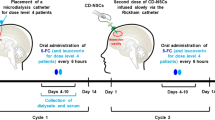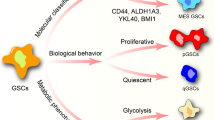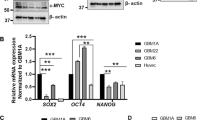Abstract
We evaluated a new therapeutic strategy for malignant glioma, which combines intratumoral inoculation of mesenchymal stem cells (MSCs) expressing cytosine deaminase gene with 5-fluorocytosine (5-FC) administration. For in vitro and in vivo experiments, MSCs were transfected with adenovirus carrying either enhanced green fluorescent protein gene (AdexCAEGFP) or cytosine deaminase gene (AdexCACD), to establish MSC-expressing EGFP (MSC-EGFP) or CD (MSC-CD). Co-culture of 9L glioma cells with MSC-CD in a medium containing 5-FC resulted in a remarkable reduction in 9L cell viability. The migratory ability of MSC-EGFP toward 9L cells was demonstrated by double-chamber assay. For the in vivo study, rats harboring 9L brain tumors were inoculated with MSC-EGFP or MSC-CD. Immunohistochemistry of rat brain tumors inoculated with MSC-EGFP showed intratumoral distribution of MSC-EGFP. Survival analysis of rats bearing 9L gliomas treated with intratumoral MSC-CD and intraperitoneal 5-FC resulted in significant prolongation of survival compared with control animals. In conclusion, molecular therapy combining suicide gene therapy and MSCs as a targeting vehicle represents a potential new therapeutic approach for malignant glioma, both with respect to the antitumor potential of this system and its neuroprotective effect on normal brain tissue.
This is a preview of subscription content, access via your institution
Access options
Subscribe to this journal
Receive 12 print issues and online access
$259.00 per year
only $21.58 per issue
Buy this article
- Purchase on Springer Link
- Instant access to full article PDF
Prices may be subject to local taxes which are calculated during checkout







Similar content being viewed by others
References
Davis FG, McCarthy BJ, Berger MS . Centralized databases available for describing primary brain tumor incidence, survival, and treatment: Central Brain Tumor Registry of the United States; Surveillance, Epidemiology, and End Results; and National Cancer Data Base. Neuro Oncol 1999; 1: 205–211.
Kim SM, Lim JY, Park SI, Jeong CH, Oh JH, Jeong M et al. Gene therapy using TRAIL-secreting human umbilical cord blood-derived mesenchymal stem cells against intracranial glioma. Cancer Res 2008; 68: 9614–9623.
Aboody KS, Brown A, Rainov NG, Bower KA, Liu S, Yang W et al. Neural stem cells display extensive tropism for pathology in adult brain: evidence from intracranial gliomas. Proc Natl Acad Sci USA 2000; 97: 12846–12851.
Barresi V, Belluardo N, Sipione S, Mudo G, Cattaneo E, Condorelli DF . Transplantation of prodrug-converting neural progenitor cells for brain tumor therapy. Cancer Gene Ther 2003; 10: 396–402.
Ehtesham M, Kabos P, Gutierrez MA, Chung NH, Griffith TS, Black KL et al. Induction of glioblastoma apoptosis using neural stem cell-mediated delivery of tumor necrosis factor-related apoptosis-inducing ligand. Cancer Res 2002; 62: 7170–7174.
Pittenger MF, Mackay AM, Beck SC, Jaiswal RK, Douglas R, Mosca JD et al. Multilineage potential of adult human mesenchymal stem cells. Science 1999; 284: 143–147.
Prockop DJ . Stem cell research has only just begun. Science 2001; 293: 211–212.
Kurozumi K, Nakamura K, Tamiya T, Kawano Y, Ishii K, Kobune M et al. Mesenchymal stem cells that produce neurotrophic factors reduce ischemic damage in the rat middle cerebral artery occlusion model. Mol Ther 2005; 11: 96–104.
Kurozumi K, Nakamura K, Tamiya T, Kawano Y, Kobune M, Hirai S et al. BDNF gene-modified mesenchymal stem cells promote functional recovery and reduce infarct size in the rat middle cerebral artery occlusion model. Mol Ther 2004; 9: 189–197.
Nakamizo A, Marini F, Amano T, Khan A, Studeny M, Gumin J et al. Human bone marrow-derived mesenchymal stem cells in the treatment of gliomas. Cancer Res 2005; 65: 3307–3318.
Nakamura K, Ito Y, Kawano Y, Kurozumi K, Kobune M, Tsuda H et al. Antitumor effect of genetically engineered mesenchymal stem cells in a rat glioma model. Gene Ther 2004; 11: 1155–1164.
Mullen CA, Kilstrup M, Blaese RM . Transfer of the bacterial gene for cytosine deaminase to mammalian cells confers lethal sensitivity to 5-fluorocytosine: a negative selection system. Proc Natl Acad Sci USA 1992; 89: 33–37.
Ichikawa T, Tamiya T, Adachi Y, Ono Y, Matsumoto K, Furuta T et al. In vivo efficacy and toxicity of 5-fluorocytosine/cytosine deaminase gene therapy for malignant gliomas mediated by adenovirus. Cancer Gene Ther 2000; 7: 74–82.
Kucerova L, Matuskova M, Pastorakova A, Tyciakova S, Jakubikova J, Bohovic R et al. Cytosine deaminase expressing human mesenchymal stem cells mediated tumour regression in melanoma bearing mice. J Gene Med 2008; 10: 1071–1082.
Park SA, Ryu CH, Kim SM, Lim JY, Park SI, Jeong CH et al. CXCR4-transfected human umbilical cord blood-derived mesenchymal stem cells exhibit enhanced migratory capacity toward gliomas. Int J Oncol 2011; 38: 97–103.
Schichor C, Birnbaum T, Etminan N, Schnell O, Grau S, Miebach S et al. Vascular endothelial growth factor A contributes to glioma-induced migration of human marrow stromal cells (hMSC). Exp Neurol 2006; 199: 301–310.
Birnbaum T, Roider J, Schankin CJ, Padovan CS, Schichor C, Goldbrunner R et al. Malignant gliomas actively recruit bone marrow stromal cells by secreting angiogenic cytokines. J Neurooncol 2007; 83: 241–247.
Xu F, Shi J, Yu B, Ni W, Wu X, Gu Z . Chemokines mediate mesenchymal stem cell migration toward gliomas in vitro. Oncol Rep 2010; 23: 1561–1567.
Giese A, Westphal M . Glioma invasion in the central nervous system. Neurosurgery 1996; 39: 235–250; discussion 250–252.
Friedlander DR, Zagzag D, Shiff B, Cohen H, Allen JC, Kelly PJ et al. Migration of brain tumor cells on extracellular matrix proteins in vitro correlates with tumor type and grade and involves alphaV and beta1 integrins. Cancer Res 1996; 56: 1939–1947.
Onishi M, Ichikawa T, Kurozumi K, Date I . Angiogenesis and invasion in glioma. Brain Tumor Pathol 2011; 28: 13–24.
Onda T, Honmou O, Harada K, Houkin K, Hamada H, Kocsis JD . Therapeutic benefits by human mesenchymal stem cells (hMSCs) and Ang-1 gene-modified hMSCs after cerebral ischemia. J Cereb Blood Flow Metab 2008; 28: 329–340.
Li Y, Chen J, Chen XG, Wang L, Gautam SC, Xu YX et al. Human marrow stromal cell therapy for stroke in rat: neurotrophins and functional recovery. Neurology 2002; 59: 514–523.
Kimura S, Yoshino A, Katayama Y, Watanabe T, Fukushima T . Growth control of C6 glioma in vivo by nerve growth factor. J Neurooncol 2002; 59: 199–205.
Chen XC, Wang R, Zhao X, Wei YQ, Hu M, Wang YS et al. Prophylaxis against carcinogenesis in three kinds of unestablished tumor models via IL12-gene-engineered MSCs. Carcinogenesis 2006; 27: 2434–2441.
Studeny M, Marini FC, Champlin RE, Zompetta C, Fidler IJ, Andreeff M . Bone marrow-derived mesenchymal stem cells as vehicles for interferon-beta delivery into tumors. Cancer Res 2002; 62: 3603–3608.
Borden EC, Kim K, Ryan L, Blum RH, Shiraki M, Tormey DC et al. Phase II trials of interferons-alpha and -beta in advanced sarcomas. J Interferon Res 1992; 12: 455–458.
Mohr A, Lyons M, Deedigan L, Harte T, Shaw G, Howard L et al. Mesenchymal stem cells expressing TRAIL lead to tumour growth inhibition in an experimental lung cancer model. J Cell Mol Med 2008; 12 (6B): 2628–2643.
Kurozumi K, Hardcastle J, Thakur R, Shroll J, Nowicki M, Otsuki A et al. Oncolytic HSV-1 infection of tumors induces angiogenesis and upregulates CYR61. Mol Ther 2008; 16: 1382–1391.
Kurozumi K, Hardcastle J, Thakur R, Yang M, Christoforidis G, Fulci G et al. Effect of tumor microenvironment modulation on the efficacy of oncolytic virus therapy. J Natl Cancer Inst 2007; 99: 1768–1781.
Kambara H, Okano H, Chiocca EA, Saeki Y . An oncolytic HSV-1 mutant expressing ICP34.5 under control of a nestin promoter increases survival of animals even when symptomatic from a brain tumor. Cancer Res 2005; 65: 2832–2839.
Komarova S, Kawakami Y, Stoff-Khalili MA, Curiel DT, Pereboeva L . Mesenchymal progenitor cells as cellular vehicles for delivery of oncolytic adenoviruses. Mol Cancer Ther 2006; 5: 755–766.
Amano S, Li S, Gu C, Gao Y, Koizumi S, Yamamoto S et al. Use of genetically engineered bone marrow-derived mesenchymal stem cells for glioma gene therapy. Int J Oncol 2009; 35: 1265–1270.
Grignet-Debrus C, Calberg-Bacq CM . Potential of Varicella zoster virus thymidine kinase as a suicide gene in breast cancer cells. Gene Ther 1997; 4: 560–569.
Lee J, Elkahloun AG, Messina SA, Ferrari N, Xi D, Smith CL et al. Cellular and genetic characterization of human adult bone marrow-derived neural stem-like cells: a potential antiglioma cellular vector. Cancer Res 2003; 63: 8877–8889.
Rubio D, Garcia-Castro J, Martin MC, de la Fuente R, Cigudosa JC, Lloyd AC et al. Spontaneous human adult stem cell transformation. Cancer Res 2005; 65: 3035–3039.
Pike-Overzet K, van der Burg M, Wagemaker G, van Dongen JJ, Staal FJ . New insights and unresolved issues regarding insertional mutagenesis in X-linked SCID gene therapy. Mol Ther 2007; 15: 1910–1916.
Acknowledgements
We thank H Wakimoto, M Arao and A Ishikawa for their technical assistance. The following medical students also contributed to the animal experiments: T Oka, K Tanaka, H Honda, K Seno and H Okura. This study was supported by grants-in-aid for Scientific Research from the Japanese Ministry of Education, Culture, Sports, Science and Technology to TI (No. 19591675), HK (No. 19591676) and KK (No. 20890133; No. 21791364).
Author information
Authors and Affiliations
Corresponding author
Ethics declarations
Competing interests
The authors declare no conflict of interest.
Rights and permissions
About this article
Cite this article
Kosaka, H., Ichikawa, T., Kurozumi, K. et al. Therapeutic effect of suicide gene-transferred mesenchymal stem cells in a rat model of glioma. Cancer Gene Ther 19, 572–578 (2012). https://doi.org/10.1038/cgt.2012.35
Received:
Revised:
Accepted:
Published:
Issue Date:
DOI: https://doi.org/10.1038/cgt.2012.35
Keywords
This article is cited by
-
Intracerebral Administration of Autologous Mesenchymal Stem Cells as HSV-TK Gene Vehicle for Treatment of Glioblastoma Multiform: Safety and Feasibility Assessment
Molecular Neurobiology (2021)
-
Recent progress in the research of suicide gene therapy for malignant glioma
Neurosurgical Review (2021)
-
Oncolytic Newcastle disease virus delivered by Mesenchymal stem cells-engineered system enhances the therapeutic effects altering tumor microenvironment
Virology Journal (2020)
-
A facile and scalable in production non-viral gene engineered mesenchymal stem cells for effective suppression of temozolomide-resistant (TMZR) glioblastoma growth
Stem Cell Research & Therapy (2020)
-
Current status and potential challenges of mesenchymal stem cell-based therapy for malignant gliomas
Stem Cell Research & Therapy (2018)



